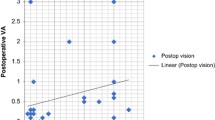Abstract
Perforating and penetrating globe injuries secondary to peribulbar and retrobulbar anaesthesia are often complicated by vitreous haemorrhage and retinal detachment. We describe the effectiveness of primary silicone oiltamponade in the repair of three perforatedglobes secondary to local anaesthesia for ophthalmic surgery.
Three patients with axial myopia had peribulbar and retrobulbar anaesthesia for extracapsular cataract extraction (two patients) and cryotherapy (one patient). All eyes sustained a vitreous haemorrhage obscuring the view to the fundus. Retinal detachments were detected by B-scan ultrasound. In all eyes, scleral buckling, pars plana vitrectomy and silicone oil tamponade were performed as a primary surgical procedure. All the patients had complete anatomic reposition. In two patients, after two years follow-up, visual acuity was between 6/12to 6/36 with the retina attached and no proliferative vitreoretinopathy (PVR). The third patient had blind painful eye and enucleation was performed. Primary use of silicone oil tamponade, in the management of perforated globe with retinal detachment due to local anaesthesia injection, is recommended.
Similar content being viewed by others
References
Kuhn F, Morris R, Witherspoon D, Heimann K, Treister G. A standardized classification of ocular trauma. Ophthalmol 1996; 103: 240–3.
Katsev DA, Drews RC, Rose BT. An anatomic study of retrobulbar needle path length. Ophthalmol 1989; 96: 1221–4.
Grizzard WS, Kirk NM, Pavan PR, Antworth MV, Hammer ME, Roseman RL. Perforating ocular injuries caused by anaesthesia personnel. Ophthalmol 1991; 98: 1011–6.
Waller SG, Taboada J, O’Connor P. Retrobulbar anaesthesia risk. Ophthalmol 1993; 100: 506–10.
Boniuk V, Nockowitz R. Perforation of the globe during retrobulbar injection: Medicolegal aspects of four cases. Surv ophthalmol 1994; 39: 141–5.
Hay A, Flynn HW, Hoffman JI, Rivera AH. Needle penetration of the globe during retrobulbar and peribulbar injections. Ophthalmol 1991; 98: 1017–24.
Duker JS, Belmont JB, Benson WE, Brooks HL, Brown GC, Federman JL, Fischer DH, Tasman WS. Inadvertent globe perforation during retrobulbar and peribulbar anaesthesia. Ophthalmol 1991; 98: 519–26.
Lemmen KD, Heimann K. Early vitrectomy with primary silicone oil filling in severely injured eyes. Klin Mbl Augenheilk 1988; 193: 594–601.
Bartz-Schmidt KU, Kirchhof B, Meyer-Stoll T, Walter P, Heimann K. Primary silicone oil endotamponade in the management of severe ocular injuries. XXth Meeting of the Club Jules Gonin, Bern, Switzerland, 1996. Paper 128.
Author information
Authors and Affiliations
Rights and permissions
About this article
Cite this article
Rosenthal, G., Bartz-Schmidt, K., Engels, B. et al. Primary use of silicone oil tamponade in the management of perforating globe injury secondary to inadvertent local anaesthesia injection for ophthalmic surgery. Int Ophthalmol 21, 349–352 (1997). https://doi.org/10.1023/A:1006027931938
Issue Date:
DOI: https://doi.org/10.1023/A:1006027931938




